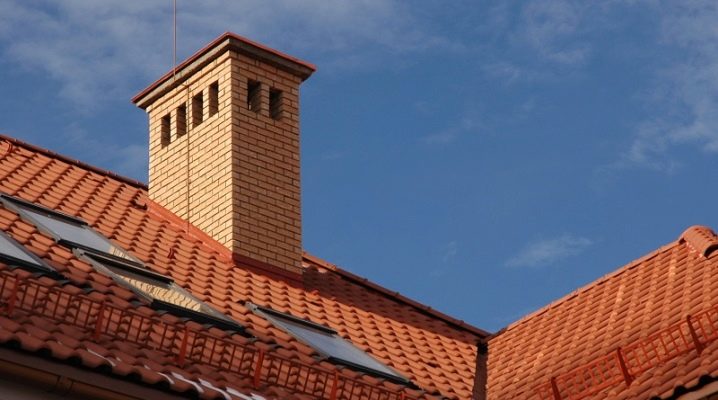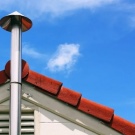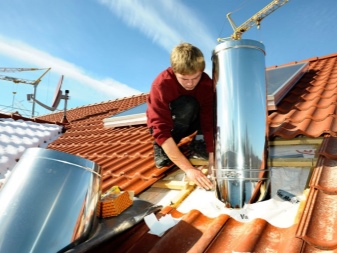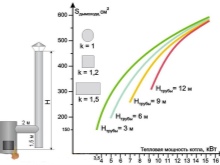Chimney height relative to the ridge

The height of the chimney relative to the ridge of the roof, calculated and chosen incorrectly, can cause back draft, threatening death to all residents of a country house who left the stove to heat up overnight, and did not use, for example, electric heating.






What does height affect?
The height of the chimney relative to the ridge of the roof affects a number of parameters.
- Comfort when using the oven. The lower the height, the better the draft between the chimney and the heated room.
- Corner chimney is used, or it is located somewhere in the middle of the furnace room.
- The amount of combustion products that carry harmful substances into the atmosphere. According to statistics, it is for this reason that most fires start due to faulty stoves.
- Sanitary area - the distance from the building wall to the chimney... It should be equal to 1.5 m.
- The higher the chimney as a whole, the more smoke it will let through into the room. To prevent smoke from entering the room, the chimney should be at least 50 cm higher than the ridge of the roof if it is located on the ridge itself, but this rarely happens.
- The height of the chimney itself depends little on its position relative to the ridge... For most cases, this is all the same half a meter from the plane of the roof slope - a sample is taken along the central longitudinal line inside the closed space of the pipe itself.
- The ability to quickly clog the pipe lumen with soot in conditions when heavily smoky is used when burning in an ordinary stove (it contains a single-chamber combustion compartment) fuel, for example, fuel oil, oil processing, polystyrene and others.
The listed parameters allow you to avoid mistakes when installing the chimney.


What should it be?
The height of the chimney relative to the ridge of the roof is chosen not lower than 10 degrees relative to the horizon. In this case, the ridge of the roof is considered the apex of this angle, and the central line of the inner space of the pipe, drawn along, recedes from the ridge line by 3 m or more. But even if you install the chimney so that the top of the chimney is as high as possible in relation to the ridge, it can be fraught with consequences. The top of the chimney is placed at least below the roof ridge if the distance between both of them is less than 3 m. The meaning of this calculation is that the wind blows the pipe head, creating the necessary outward thrust, and not back.


Too low in relation to the ridge of the roof (the angle to the horizon, facing downward, is more than 10 degrees) will make it impossible to efficiently and quickly pull from the indoor premises. If the power of the stove is large, and the diameter of the chimney is insufficient (this is determined by appropriate calculations) or is the minimum permissible in this situation, then errors in calculating the total height of the pipe (about 5 m from the grate) will easily lead to reverse draft, which is dangerous for the life of the residents of the house.



The height of the chimney above the gable roof is determined by the same values of the initial parameters as above the gable roof. The number of roof slopes does not significantly affect compliance with the above rule. If the total height of the pipe is more than 5 m, then the draft is not enough to efficiently and quickly remove exhaust gases and soot from the furnace outside the house. The minimum pipe height is determined by the roof structure and the height of the house.... For an ordinary garage with a height of 2.5 meters, the height of the pipe should be at least 3 m, counting from the floor or grate, when the roof of the garage is flat. The same rule applies to any outbuildings with an attic roof.


For other buildings with a classic gable roof with an attic, the width of the slope, according to the above rule, is not more than 3 m - relative to the center line of the pipe itself, provided that the top (end of the head) coincides with the height of the ridge. The height of the chimney for a sauna stove is determined primarily by the level of the grate, on which the wood is burning. The stove is located as close as possible to the middle of the bath room, and in this case the same rules apply for sloping, single and gable roofs. According to the standards, above a flat roof, the height of the pipe (there is no roof ridge) is at least 0.5 m, but it can be additionally increased to a total height of 5 m.
Horizontal pipe crossings - no more than one and no longer than a meter, while it is advisable to withstand a slight slope of the pipe upward (but not downward - otherwise the thrust would stop).


General and specific advice on choosing the height of the pipe relative to the ridge comes down to the following, try not to bypass them.
- The height of the chimney is set along the ridge, taking into account the structural features of the building... Its height must be at least 5 meters.
- The wider and higher the pipe, the better the thrust... The narrower the chimney, the less smoke will come out.
- The wider the pipe, the more it will be possible to heat the air inside the room where the stove is located. A taller pipe creates a higher combustion temperature, and a narrower pipe creates a lower one.
- The chimney is not covered by a canopy roof or other objects... If you neglect this rule, then condensation can accumulate on the roof, which leads to its destruction.
- So that smoke does not come out through the joints in the pipe, the sections are carefully joined together.
- The chimney is located at least 40 cm from the ridge.
- In this case, the height of the pipe should be selected in accordance with the height of the ridge. - not less than half a meter from the top of the ridge to the top of the pipe. It is impossible to place the pipe closer than 40 cm from the ridge run.
- If the pipe height is not chosen according to the height of the ridge, then in case of precipitation, smoke will penetrate into the house, and not go out through the chimney.
- The height of the pipe is selected taking into account the temperature at which combustion will occur... The higher the temperature, the higher and wider the pipe should be.
- The higher the pipe, the more the wind affects its stability.
- The height of the pipe, set along the ridge of the roof, does not affect the power and efficiency of the stove, as well as vice versa. The power of the stove affects only the diameter of the chimney section - and not in any way the height of the pipe relative to the ridge and its overall height (from the grate to the mouth of the chimney at the top).
- In most cases, the height of the chimney above the roof should not exceed 1 meter when the roof is flat... A meter above the ridge of a multi-slope roof will also be enough. It makes sense to build a higher chimney only when a neighbor next to you complains about a strong smell of smoke (for example, your stove smokes heavily), while his house is on the leeward side, and not on the other sides.
The listed recommendations and the method for determining the height of the pipe above the ridge should not be violated, even when using an additional blower fan installed in the stove door in the oven and a good air flow from the outside. This is important from the standpoint of the safety of life and health of residents of a country house.


Performing calculations
In addition to reducing the traction force, the second unpleasant surprise will be the inability to light the stove or the fuel boiler. In addition to the difficulty with fuel combustion, the third "bonus" will be turbulence in the pipe, which invariably leads to gas contamination of the room with exhaust gases and soot. The fact is that the wind, meeting with the chimney above the roof, is forced to “turn” in the other direction in its immediate vicinity.
A change in the direction of the wind near the pipe provokes the effect of suction of what comes out of it during the operation of the furnace.The wind picks up the outgoing smoke - if you create serious obstacles for it, then the smoke will not come out all in a short time, it will accumulate in the pipe, and the slightest change in air masses will contribute to the reverse thrust. To these factors, the ridge height, which closes the chimney from the wind from the outside, can cause poor draft.


For example, when the ridge of the roof blocks the north wind from the chimney, while the chimney relative to the ridge is placed on the south side (south slope), the draft is noticeably reduced. And it is worth blowing, on the contrary, to the south wind, then, bypassing this ridge, it will contribute to the reverse blowing of smoke into the chimney.
And although an adjustable damper with certain parameters can be installed in the chimney inside, partially blocking these attempts by the wind to blow smoke, ready to exit the chimney, back into it, as well as a relatively high combustion chamber of the same firewood, a relatively small door opening through which they are loaded the same firewood, it will not be possible to completely get rid of the reverse thrust. The owner of the house is forced to wait for a "favorable" wind direction, or to heat the stove only when it is completely calm or very weak movement of air masses.



When calculating, consider the following features.
- Calculations of the location and dimensions, the length of the outer (outer) part of the chimney are based on SNiP 4101 (revision 2003), valid for furnace heating... Another calculation parameter - the height of the pipe above the ridge - is equal to half a meter with a distance between the plane of the ridge or the middle of the pipe in the longitudinal section of not more than 1.5 m. The plane of measurement of this distance is parallel to the earth's horizon and strictly perpendicular to the vertical part of the chimney.
- The top of the chimney coincides in level with the upper ridge rib when this distance fluctuates in the course of other calculations of the chimney and roof from 1.5 to 3 m.
- You can not place the chimney on the ridge, from which it would come out. Only an approximation to it is allowed. It will also reduce chimney costs.
- The exhaust pipe, launched in the room where the stove is installed, in the forced ventilation mode, is located at the mouth not below the chimney mouth. If you violate this rule, in case of a downstream stormy or hurricane wind, you will achieve partial blowing of the just exhaust gases into the room. If there is no supply ventilation, then open any vent only on the windward side, and not on the leeward side, when the stove is operating at full capacity.
- It is not recommended to build on a high chimney: it can fall, it cannot be positioned without guy wires (pipe length 1 m or more).
- The distance to the wooden floors from the pipe for the gas boiler is at least 0.5 m. For a solid fuel boiler, a liquid-fired stove and for a wood-burning stove, it reaches 65 cm. This is necessary to prevent a fire (protection by distance from overheating).
- To calculate how much the pipe should be lower than the ridge at a distance of more than 3 m from it, multiply this distance by the tangent of 10 degrees of the technological angle, determined in this case according to SNiP.



Adhering to the obtained numerical values, on the project, draw a diagram of the location of the pipe relative to the ridge, and during the construction of the heating system, translate the obtained values (except for angles) from scaled to real ones.
These requirements are taken into account both in new construction and during the reconstruction of an already old heating and furnace system; they are valid for both single-slope and dual-slope roofs. Long-burning stoves that use pyrolysis, which allows you to burn any fuel without smoke, are designed according to the same principle of choosing the height of the chimney.















The comment was sent successfully.